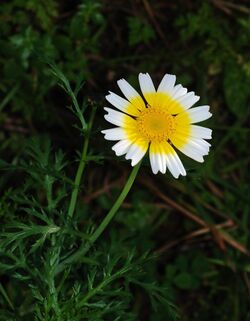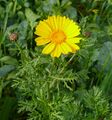Biology:Glebionis coronaria
| Garland chrysanthemum | |
|---|---|

| |
| Scientific classification | |
| Kingdom: | Plantae |
| Clade: | Tracheophytes |
| Clade: | Angiosperms |
| Clade: | Eudicots |
| Clade: | Asterids |
| Order: | Asterales |
| Family: | Asteraceae |
| Genus: | Glebionis |
| Species: | G. coronaria
|
| Binomial name | |
| Glebionis coronaria (L.) Cass. ex Spach
| |
| Synonyms[1] | |
|
List
| |
| Wikimedia Commons has media related to Glebionis coronaria. |
Glebionis coronaria, formerly called Chrysanthemum coronarium, is a species of flowering plant in the daisy family. It is native to the Mediterranean region.[2] It is cultivated and naturalized in East Asia and in scattered locations in North America.[3][4]
Glebionis coronaria is used as a leaf vegetable. English language common names include garland chrysanthemum,[5] chrysanthemum greens,[5] edible chrysanthemum, crowndaisy chrysanthemum,[6] chop suey greens,[5] crown daisy,[5] and Japanese greens.[5]
Glebionis coronaria has been hybridized with related Argyranthemum species to create cultivars of garden marguerites.[7]
Characteristics
A leafy herb, the garland chrysanthemum is an annual plant. It has yellow ray florets grouped in small flower heads and aromatic, bipinnately lobed leaves.[8]
The vegetable grows very well in mild or slightly cold climates, but will go quickly into premature flowering in warm summer conditions. Seeds are sown in early spring and fall.[citation needed]
"The plant is rich in minerals and vitamins with potassium concentrations at 610 mg/100 g and carotene at 3.4 g/100 g in edible portions. In addition, the plant contains various antioxidants (in stem, leaf, and root tissues) that have potential long-term benefits for human health, although toxic (dioxin) properties have also been observed. Extracts from C. coronarium var. spatiosum have been shown to inhibit growth of Lactobacillus casei, a beneficial human intestinal bacterium."[9]
Culinary uses
| Nutritional value per 100 g (3.5 oz) | |
|---|---|
| Energy | 99 kJ (24 kcal) |
3.02 g | |
| Dietary fiber | 3 g |
0.56 g | |
3.36 g | |
| Vitamins | Quantity %DV† |
| Vitamin A equiv. | 15% 116 μg13% 1380 μg3834 μg |
| Thiamine (B1) | 11% 0.13 mg |
| Riboflavin (B2) | 12% 0.144 mg |
| Niacin (B3) | 5180% 777 mg |
| Pantothenic acid (B5) | 4% 0.221 mg |
| Vitamin B6 | 14% 0.176 mg |
| Folate (B9) | 44% 177 μg |
| Vitamin C | 2% 1.4 mg |
| Vitamin K | 333% 350 μg |
| Minerals | Quantity %DV† |
| Calcium | 12% 117 mg |
| Iron | 18% 2.29 mg |
| Magnesium | 9% 32 mg |
| Manganese | 45% 0.943 mg |
| Sodium | 8% 118 mg |
| Zinc | 7% 0.71 mg |
| |
| †Percentages are roughly approximated using US recommendations for adults. Source: USDA Nutrient Database | |
The plant's greens are used in many Asian cuisines. It is widely available in China where it is called 茼蒿(菜) (Cantonese tong ho (choy), Mandarin tónghāo (cài)) and appears in multiple Chinese cuisines as a ingredient for stir fries, stews, casseroles, and hotpots.[10] In Japanese cuisine, it is called "spring chrysanthemum" (Japanese: 春菊, romanized: shungiku), and is used in nabemono, mixed into rice, or drizzled with soy sauce and sesame seeds as a side dish. Korean cuisine uses the greens in soups, stews, and alone as a side dish (banchan). In Vietnamese cuisine, the greens are known as (Vietnamese: cải cúc) or (Vietnamese: tần ô), and are used in soup (canh) or as a side dish accompanying various noodle soups. In a hotpot, it is added at the last moment to the pot to avoid overcooking.[citation needed]
In Crete, a variety of the species called mantilida (μαντηλίδα) has its tender shoots eaten raw or steamed by the locals (see Greek cuisine).[citation needed]
Gallery
References
- ↑ "The Plant List: A Working List of All Plant Species". http://www.theplantlist.org/tpl1.1/record/gcc-28875.
- ↑ Altervista Flora Italiana, Glebionis coronaria (L.) Spach includes photos and European distribution map
- ↑ Flora of China, Glebionis coronaria (Linnaeus) Cassini ex Spach, 1841. 茼蒿 tong hao
- ↑ Biota of North America Program 2014 county distribution map
- ↑ 5.0 5.1 5.2 5.3 5.4 {{citation | mode = cs1 | title = Glebionis coronaria | work = Germplasm Resources Information Network (GRIN) | url = https://npgsweb.ars-grin.gov/gringlobal/taxonomydetail.aspx?417417 | publisher = [[Organization:Agricultural Research ServAgricultural Research Service (ARS), United States Department of Agriculture (USDA) | access-date = 2014-07-30 }}
- ↑ "쑥갓" (in ko). Korea National Arboretum. http://nature.go.kr/kbi/plant/pilbk/selectPlantPilbkDtl.do?plantPilbkNo=30125.
- ↑ Flores, Anita; Shaw, Julian; Watson, John (2018), "Unpicking a daisy chain", The Plantsman, New Series 17 (4): 238–243
- ↑ Flora of North America, Glebionis coronaria (Linnaeus) Cassini ex Spach, 1841. Crown daisy, garland chrysanthemum
- ↑ Teixeira da Silva, J. A., et al. (2005). Important secondary metabolites and essential oils of species within the Anthemideae (Asteraceae). Journal of Herbs, Spices & Medicinal Plants 11(1), 1-4.
- ↑ Diversivore https://www.diversivore.com/ingredient-pages/garland-chrysanthemum/ Retrieved 22/9/20.
External links
Wikidata ☰ {{{from}}} entry










